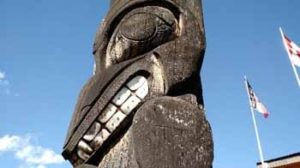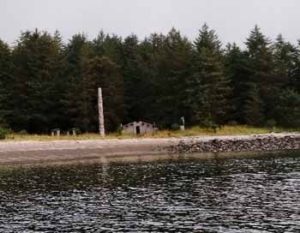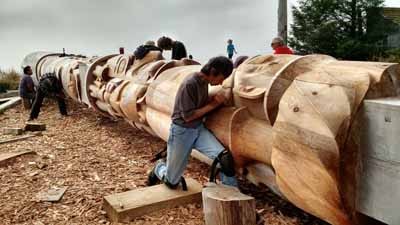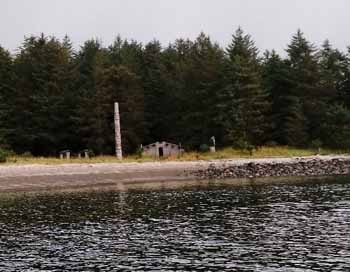Bob and I have been travelling this month in some remote areas of Northern BC. Aside from wanting to get out on the lakes with our paddleboards, we feel a deep connection with First Nations people and wanted to learn more of their history and spirituality. What we got was so much more than we expected – a lesson in forgiveness. Forgiveness may not be listed specifically as a yama or niyama, but it comes as a result of practicing truthfulness, non-stealing, contentment, Svadyaya… it is an underlying benefit of practicing yoga ethics.
First we visited “the Hazeltons”, the Ksan Historical Village, and Kispiox. Learning to read the poles outside each longhouse bearing the family crests was an enlightening experience. Each pole records a bit of history and information about that family or village.
 We headed north to the Nisga’a Nation in the Nass Valley, where three villages were buried under volcanic lava around 250 years ago. Four villages remain today: Gitlax̱t’aamiks (New Aiyansh), Gitwinksihlkw (Canyon City), Lax̱g̱alts’ap (Greenville), and Ging̱olx (Kincolith). Each of these villages has a different way of life, from coastal to inland, and the people were warm and eager to speak with us. At Lax̱g̱alts’ap there is the Nisga’a Museum where this young First Nations man was passionate to share the history of these villages, and filled us with stories and deeper understanding of the shamans, gatherings, clans, crests, and the impact of white civilization on their lives. The Lava Bed Park is worth spending some time at, as the lichens and lava tubes are quite beautiful.
We headed north to the Nisga’a Nation in the Nass Valley, where three villages were buried under volcanic lava around 250 years ago. Four villages remain today: Gitlax̱t’aamiks (New Aiyansh), Gitwinksihlkw (Canyon City), Lax̱g̱alts’ap (Greenville), and Ging̱olx (Kincolith). Each of these villages has a different way of life, from coastal to inland, and the people were warm and eager to speak with us. At Lax̱g̱alts’ap there is the Nisga’a Museum where this young First Nations man was passionate to share the history of these villages, and filled us with stories and deeper understanding of the shamans, gatherings, clans, crests, and the impact of white civilization on their lives. The Lava Bed Park is worth spending some time at, as the lichens and lava tubes are quite beautiful.
 From here we went over to Haida Gwaii. We met Oliver, a Haida, who took us by boat to the ancient site of the village of Yan. He taught us more about the longhouse, the poles including memorial poles for recording events, mortuary poles that held those who died, house poles that told you who lived there, and even shame poles when a member of the village didn’t pay their debt (these poles were removed when the debt was paid).
From here we went over to Haida Gwaii. We met Oliver, a Haida, who took us by boat to the ancient site of the village of Yan. He taught us more about the longhouse, the poles including memorial poles for recording events, mortuary poles that held those who died, house poles that told you who lived there, and even shame poles when a member of the village didn’t pay their debt (these poles were removed when the debt was paid).
There is a memorial pole currently being carved by four Haida carvers (designed by James Hart) to honour the Truth and Reconciliation report and movement forward. The pole records the progression from life before contact with European immigrants and missionaries, through the trauma of residential schools and the loss of their culture and languages, to acknowledgement and reconciliation, into the new future that lies ahead. The pole will be raised at UBC around mid-October, and all are welcome to participate in this ceremony.

This is where forgiveness comes in. Every First Nations person has been gravely impacted by people misunderstanding their culture and trying to change them. And yet today they welcome our presence in their villages. Many embrace the church for what it continues to give them. The future of relationship is heralded. These people know that resentment, hatred, and anger all lead to illness and there is no possible growth from holding on to these. Without the desire to move forward from the hurt, we will miss the opportunity for growth into a bright future. I am reminded of the book “Oneness” by Jeffrey Moses, where he says:
“The Chinese language has a word for “crisis” that is made up of two separate written symbols-one for “danger” and one for “opportunity . … Far too often, we become angry when confronted with something that blocks us from achieving a desire. Anger often flares up during the very moments when clarity and objectivity are needed most. In such instances, anger is the enemy of success…”
Life continuously throws obstacles in our path to success and happiness. How we respond to these challenges is what is important. We may feel angry and frustrated with those around us, however an objective mind can show us that every bit of growth and opportunity we experience comes out of the challenges we face. The manner with which we deal with these events is a choice. We can choose anger, discordance and suffering, which can be a dangerous path for the soul. Or, we can choose to do some soul searching and ask ourselves “What am I supposed to learn from this situation?” This practice is known as “svadhyaya” or self-study, which can lead us away from our resentment and anger. It provides the opportunity to discover new knowledge and understanding of ourselves and our strengths that can move us forward into our future. This practice takes us deeper into connecting with our True self, and guides us to a profound peace that pours over into our relationships.
Erich Schiffmann urges us to ask ourselves, “What is the Truth here, really?” This is a very deep and challenging question, with emphasis on the “really.” Ask it over and over as each answer arises. Meditate in search of the Truth. Really. Then act from a place of Love.
Our travels through First Nations’ lands are not over yet. As we continue, we are in awe of their capacity to be forgiving, welcoming and loving. We can learn so much from this. We are deeply touched by their spirit, creativity, and welcoming hearts. May we all be so blessed with these gifts. Hawaa. Bob & Mugs
Celebrating over 25 years of Teacher Training


Thanks for sharing Mugs and Bob. We had the privilege of visiting Haida Gwaii last year; the Lava beds and Kitsela village in August this year. Additionally, I was given the opportunity to work for four years with First Nations Elders in Port Alberni in the 90’s, Tsawaayuus (Rainbow Gardens). I have been intriqued by this culture – survival and spirituality which are interconnected. I learned several years later of my Cree heritage, and more recently, Mohawk.
Namaste!
thank you Dena. That is exciting about you discovering your own personal heritage and connection.